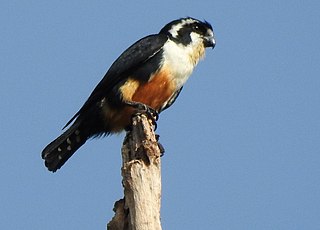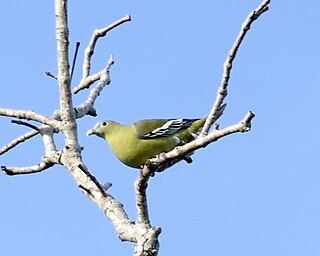
Kingfishers are a family, the Alcedinidae, of small to medium-sized, brightly coloured birds in the order Coraciiformes. They have a cosmopolitan distribution, with most species living in the tropical regions of Africa, Asia, and Oceania, but also can be found in Europe and the Americas. They can be found in deep forests near calm ponds and small rivers. The family contains 118 species and is divided into three subfamilies and 19 genera. All kingfishers have large heads, long, sharp, pointed bills, short legs, and stubby tails. Most species have bright plumage with only small differences between the sexes. Most species are tropical in distribution, and a slight majority are found only in forests.

The Javan rhinoceros, Javan rhino, Sunda rhinoceros or lesser one-horned rhinoceros is a critically endangered member of the genus Rhinoceros, of the rhinoceros family, Rhinocerotidae, and one of the five remaining extant rhinoceros species across South Asia and Africa. The Javan rhinoceros is one of the smallest rhinoceros species, along with the Sumatran, or "hairy", rhinoceros. They are superficially similar to Indian rhinos, as they have plate-like, "armored" protective skin folds, but are slightly smaller, at just 3.1–3.2 m (10–10 ft) long and 1.4–1.7 m (4.6–5.6 ft) tall, on average. The heaviest specimens weigh around 2,300 kg/2.3 tonnes, similar to a black rhinoceros. However, unlike the long and potentially lethal horns of the black or white rhinoceroses of Africa, the Javan species' single, somewhat blunted horn is usually shorter than 25 cm (9.8 in).

The white-throated kingfisher also known as the white-breasted kingfisher is a tree kingfisher, widely distributed in Asia from the Sinai east through the Indian subcontinent to China and Indonesia. This kingfisher is a resident over much of its range, although some populations may make short distance movements. It can often be found well away from water where it feeds on a wide range of prey that includes small reptiles, amphibians, crabs, small rodents and even birds. During the breeding season they call loudly in the mornings from prominent perches including the tops of buildings in urban areas or on wires.

Ujung Kulon National Park is a national park at the westernmost tip of Java, located in Sumur District of Pandeglang Regency, part of Banten province in Indonesia. It once included the volcanic island group of Krakatoa in Lampung province, although current maps has suggested the Krakatoa island group as its own protected area, the Pulau Anak Krakatau Marine Nature Reserve.

The Javan tiger was a Panthera tigris sondaica population native to the Indonesian island of Java. It was one of the three tiger populations that colonized the Sunda Islands during the last glacial period 110,000–12,000 years ago. It used to inhabit most of Java, but its natural habitat decreased continuously due to conversion for agricultural land use and infrastructure. By 1940, it had retreated to remote montane and forested areas. Since no evidence of a Javan tiger was found during several studies in the 1980s and 1990s, it was assessed as being extinct in 2008.

The sacred kingfisher is a medium-sized woodland kingfisher that occurs in mangroves, woodlands, forests and river valleys in Australia, New Zealand and other parts of the western Pacific.

The milky stork is a stork species inhabiting predominantly mangroves in Southeast Asia. It is native to Cambodia, Vietnam, Malaysia and Indonesia. It is currently included in the genus Mycteria, is around 91–97 cm (36–38 in) tall, with a wingspan of 43.5–50 cm (17.1–19.7 in) and a tail around 14.5–17 cm (5.7–6.7 in). Its plumage is white apart from a few feathers at the wings and tail. Since the 1980's, the global milky stork population has declined from 5,000 to 2,000 individuals due to habitat destruction, overfishing and illegal smuggling of chicks. It is listed as Endangered on the IUCN Red List.

The Javan hawk-eagle is a medium-sized, dark brown raptor in the family Accipitridae. It is the national bird of Indonesia, where it is commonly referred to as the real-life model for the Garuda Pancasila, which is also inspired by Garuda; a bird-like deity in Hinduism and Buddhism. The scientific name commemorates the Bartels family, who discovered it.

The black-thighed falconet is one of the smallest birds of prey, typically measuring between 14–16 centimetres (5.5–6.3 in) long, with a 27–32 centimetres (11–13 in) wingspan, which is a size comparable to a typical sparrow. It is native to Brunei, Myanmar, Thailand, Malaysia, Singapore and Indonesia, and vagrant to Sri Lanka.
The Javan scops owl is a small species of owl living mainly on western Java's high volcanos; local people refer to the owl as Celepuk Jawa. Like most owls, this nocturnal bird also has a strong ability of silent flight.

The grey-cheeked green pigeon is a species of bird in the family Columbidae. It is endemic to Indonesia. Its diet consists of fruit, primarily figs. People in Java, Indonesia commonly hunt it using nylon, in a practice known as racik.

The brown-hooded kingfisher is a species of bird in the subfamily Halcyoninae, the tree kingfishers. It has a brown head and blackish and turquoise wings. It is found in Sub-Saharan Africa, living in woodland, scrubland, forest edges, and also suburban areas. The International Union for Conservation of Nature (IUCN) has assessed it as being of least concern.

The chocolate-backed kingfisher is a species of kingfisher in the subfamily Halcyoninae which occurs in western Sub-Saharan Africa.

The striped kingfisher is a species of bird in the tree kingfisher subfamily. It was first described by Edward, Lord Stanley, in Salt's Voyage to Abyssinia in 1814 as "Chelicut kingfisher" Alaudo Chelicuti.

The forest kingfisher, also known as Macleay's or the blue kingfisher, is a species of kingfisher in the subfamily Halcyoninae, also known as tree kingfishers. It is a predominantly blue and white bird. It is found in Indonesia, New Guinea and coastal eastern and Northern Australia. Like many other kingfishers, it hunts invertebrates, small frogs, and lizards.

The Javan warty pig, also called Javan wild pig, is an even-toed ungulate in the family Suidae. It is endemic to the Indonesian islands Java and Bawean, and is considered extinct on Madura. It is listed as Endangered on the IUCN Red List since 1996.

The Javan ferret-badger is a mustelid endemic to Java and Bali, Indonesia. It is listed as Least Concern on the IUCN Red List and occurs from at least 260 to 2,230 m elevation in or close to forested areas.

Mount Halimun Salak National Park is a 400 km2 conservation area in the Indonesian province of West Java on the island of Java. Established in 1992, the park comprises two mountains, Mount Salak and Mount Halimun with an 11-kilometer forest corridor. It is located near the better known Mount Gede Pangrango National Park, but the national park should be accessed from Sukabumi, 2 hours drive to the administration post and then 2 hours drive again to Cikaniki post gate.
Andries Hoogerwerf was a Dutch track and field athlete, naturalist, ornithologist and conservationist, who spent much of his working life in the Dutch East Indies and Dutch New Guinea.

The tree kingfishers, also called wood kingfishers or Halcyoninae, are the most numerous of the three subfamilies of birds in the kingfisher family, with around 70 species divided into 12 genera, including several species of kookaburras. The subfamily appears to have arisen in Indochina and Maritime Southeast Asia and then spread to many areas around the world. Tree kingfishers are widespread through Asia and Australasia, but also appear in Africa and the islands of the Pacific and Indian Oceans, using a range of habitats from tropical rainforest to open woodlands.



















